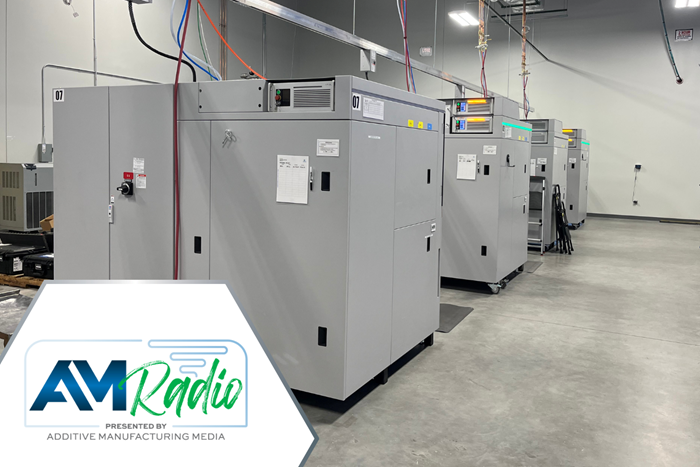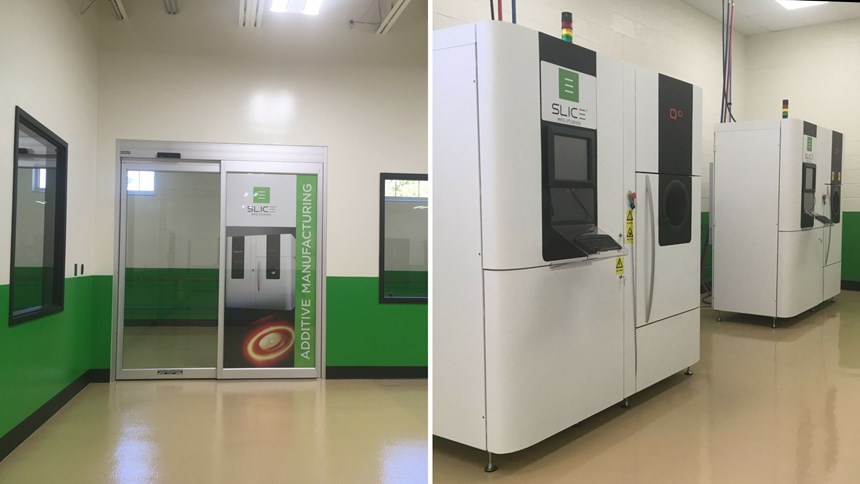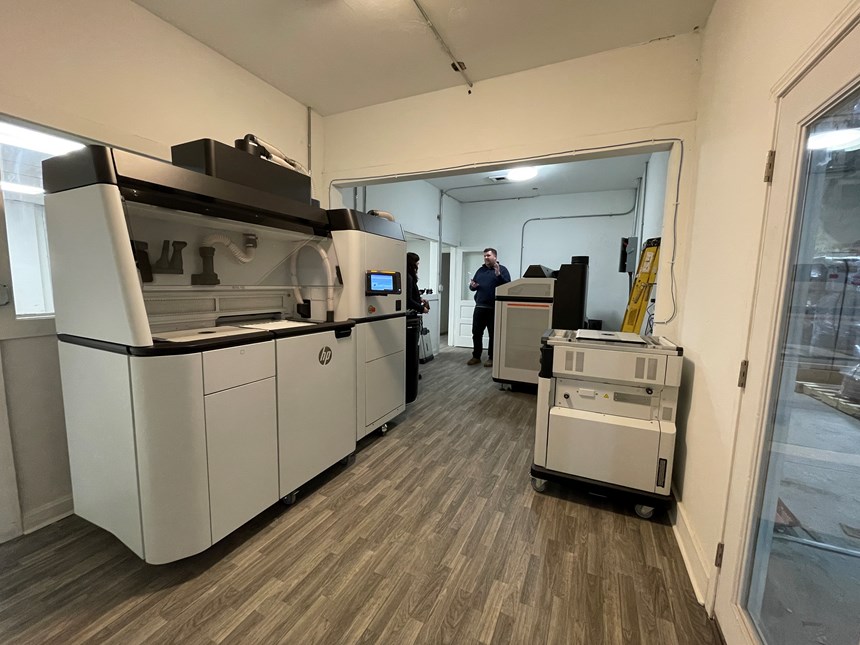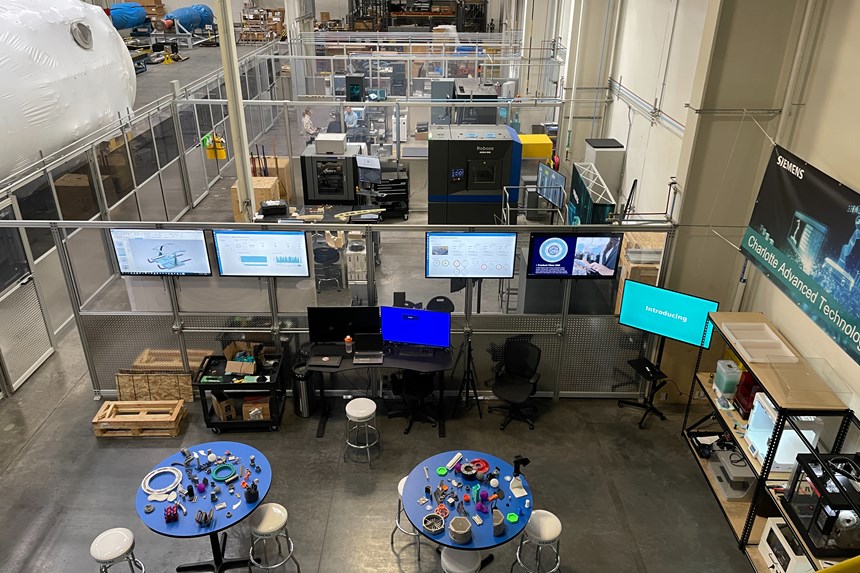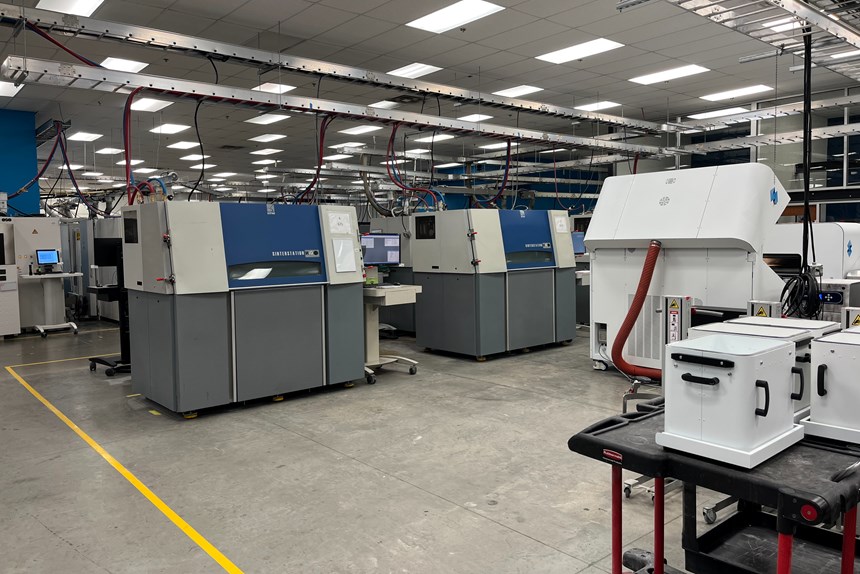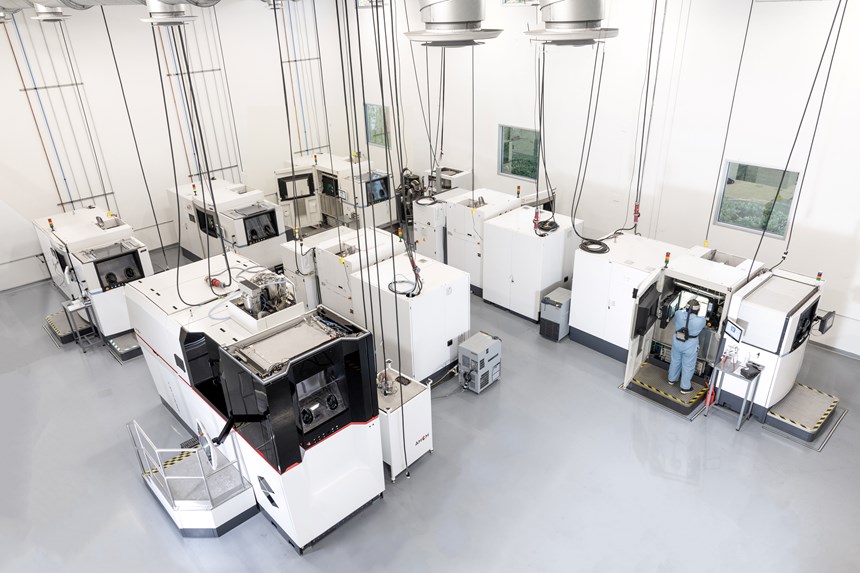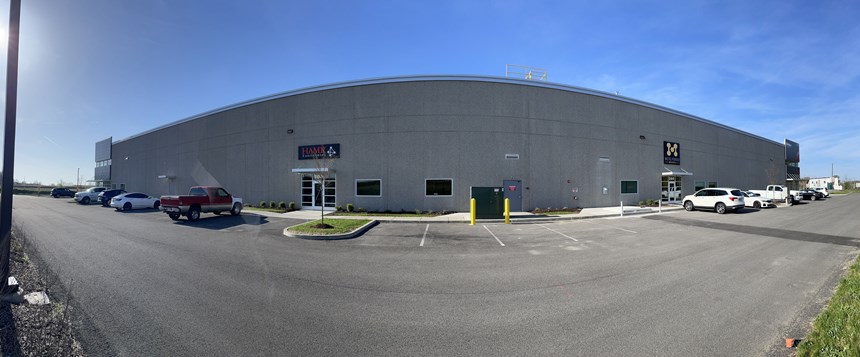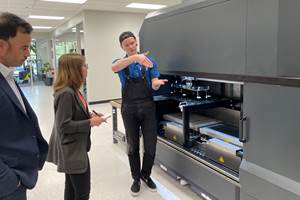Share
Read Next
Associate editor Fiona Lawler recently visited Protolabs’ brand-new facility for metal additive manufacturing in Raleigh, North Carolina. The building sits right next to an existing Protolabs facility where polymer and metal additive machines share space. But unlike that original facility, this new building was designated and built for additive manufacturing from the outset.
Additive manufacturing “factories” like this that have been built to serve the process at scale are becoming increasingly common (in fact, we devoted an entire issue of Additive Manufacturing Magazine to this phenomenon), but a purpose-built space is by no means a necessity for successfully applying AM. Effective 3D printing, and even additive production at scale, can happen in places that were never intended to serve this function provided the process or the space can flex to enable this.
In this episode of AM Radio, I talk with Fiona about her trip and we discuss the various places we’ve seen AM succeed — from a 3D printer tucked under the stairs to a rented office space to facilities built just for production additive manufacturing.
Inside Additive Manufacturing Spaces
Transcript
Stephanie Hendrixson 00:00
Protolabs recently opened a new facility dedicated to metal additive manufacturing and editor Fiona Lawler has the scoop. We'll talk about this new development and the role of the physical space for additive manufacturing. That's coming up on AM Radio.
Peter Zelinski 00:30
AM Radio is a product of Additive Manufacturing Media. So are The Cool Parts Show, The BuildUp and Additive Manufacturing magazine. Ready to be part of the AM universe? Subscribe at additivemanufacturing.media today.
Stephanie Hendrixson 00:49
Welcome to AM Radio, the show where we tune in to what's happening in additive manufacturing. I'm Stephanie Hendrixson, Executive Editor with Additive Manufacturing Media and joining me in the studio today is Associate Editor Fiona Lawler. Hi, Fiona.
Fiona Lawler 01:01
Hi, Stephanie. Thank you.
Stephanie Hendrixson 01:02
So today we're gonna be talking about additive spaces and a recent trip that you went on, Fiona. And just to kind of put this into context for our listeners, I just want to say a few things about why we travel and like why it's so important to our job. So travel is one of these things that we get to do at Additive Manufacturing Media. And it's kind of a cool and fun part of our role. And we go to kind of the standard industry events that you would expect things like Rapid, Formnext Forum, in a couple of weeks, I'm going to be going to Formnext in Frankfurt. And those events are great for just seeing a lot of technology at once, meeting people, getting good story leads. But, the truth is that a lot of our reporting comes from actually traveling to places where additive manufacturing is happening. So, companies that are technology suppliers that are developing new printers, new materials, things for the industry, but maybe even more important than that is getting to go see additive manufacturing users. So to talk to people that are using this technology in the place that they're doing it and really getting a handle on what's helping them succeed, how they're using it, and why they're using it. I guess I just want to say all that to underscore the point that getting these chances to travel is really important for us not just because it's it's a cool trip, and like we got to go somewhere interesting. But also because a lot of our reporting comes out of that, it's a good chance to kind of build those connections and see things firsthand. So Fiona, you recently got to go on one of these trips. Where did you go?
Protolabs
Yeah, so recently, I had the opportunity to visit Protolabs, specifically their new DMLS facility in Raleigh, North Carolina. This was a jam-packed, one-day trip. But the reason I went there was to see this facility that they had built from the ground up. What's interesting here is that they also have another facility on the same campus. And they were able to kind of take what they learned from this original facility that housed their 3D printing technologies, and apply it to their new facility. So for a little background context, I was invited here as part of the press to see the opening of this new facility that had just opened that week. I was able to get a guided tour actually given by Eric Utley, their 3D printing applications manager. And then I also got to meet the CEO, Robert Bodor. And both are really helpful in explaining the purpose of this new facility and how it's going to address maybe the challenges they saw with their previous facility.
Stephanie Hendrixson 03:28
So I want to ask about all that. But maybe just quick background before we dig into it, like what even is Protolabs?
Fiona Lawler 03:34
Yes, I think that would definitely be helpful. So a little context here. Protolabs is a contract manufacturer at heart. They started their manufacturing journey back in 1999 with injection molding primarily for plastic prototype parts. But a thing that Protolabs is known for is their automated software solutions. So they were kind of experimenting with how this could kind of streamline their order processing and their workflow. And kind of along the way, they noticed the trend for additive manufacturing. And so they were able to hop into this. And that is where this first predecessor facility kind of comes into play. So that facility is where they housed all of their 3D printing applications for not only metal, but polymer additive, a bunch of different things. They opened this facility in 2016. And as of recently, that's when it became full and that's kind of when they were like, Okay, we need to create a totally different facility and this facility should be focused on metal additive.
Stephanie Hendrixson 04:32
And did you get to see both of those buildings while you were there?
Fiona Lawler 04:35
I did. So actually, I got a guided tour of both buildings. It was interesting because I saw the new facility, the new DMLS facility first, and then from there, I was able to see its predecessor. So this was really cool just in a sense of compare and contrast because I was able to see this new space that was built to kind of combat maybe the challenges that they saw with the original building. One of these issues obviously being space. So something that Protolabs did, actually, with their first building that I found really interesting was that they didn't immediately fill up this space with different technologies. This was a gradual process. So when they opened it back in 2016, it took all of these years up until very recently to fill the space with, you know, all kinds of different 3D printing applications. And I think that's what they're aiming to do with this new facility as well. So Eric actually told me that the new facility is about a third of the way full right now. And this was purposeful in the sense that they're able to see trends in additive manufacturing, they're able to see the technologies their customers want, and then they're able to accommodate this with the space they have in this new facility.
Stephanie Hendrixson 05:47
So you kind of started off explaining Protolabs, like I actually didn't know that their history was in injection molding, like I've known them for their additive capacity for the last several years. But I know they do, they do lots of different things. That original facility that you saw from 2016, is it all additive manufacturing? Are there other types of technologies in there?
Fiona Lawler 06:06
When I took the tour at the first building, it was primarily additive. And then it was of course, you know, machines to support additive manufacturing, machines for postprocessing, CNC machining, all that kind of stuff.
Stephanie Hendrixson 06:17
So their main, like machining and injection molding, and like metal fabricating, like that stuff is somewhere else, it's not in.
Fiona Lawler 06:24
Yes, my understanding that somewhere else. So these, these two facilities that they have right across from each other in Raleigh are primarily focused on serving additive manufacturing.
Stephanie Hendrixson 06:33
Gotcha. So can you sort of like paint a picture of what these buildings look like? What did you see inside? What types of machines specifically? What did it look like?
Fiona Lawler 06:42
Yeah, so I'll kind of start off describing the new facilities. So the first thing I noticed right away was the open floor space, how the rooms really smoothly connected to one another, you know, they have these giant plastic screen dividers. So there's a very clear division between the rooms, but you can easily make your way from room to room, you know, you're not confused what comes next.
Stephanie Hendrixson 07:04
And so is that facility arranged in terms of like steps like printing to depowdering, to?
Fiona Lawler 07:10
Yeah, you know, so you go from your machines to your depowdering to postprocessing, they have stations where you can cut the parts off from the build plate, and then kind of you end with the manual finishing. So the machines that they're working with here, like I said, it's a direct metal laser sintering facility. So they're using actually a lot of GE Additive machines. So as of now, they have two Xline 200R large format printers, 17 of the M2 Concept Laser machines, 12 of the smaller M Lab machines, and then two M Lab 200 R machines, they have 33 machines currently, but they have the capacity to fit at least 91. So like I said, they're really taking their time and gradually building this repertoire.
Stephanie Hendrixson 07:54
Yeah, so about a third full. That's, that's sort of a huge number for it to only be a third full but but very cool that they are planning ahead and thinking that there's going to be demand for up to 91 of these machines in this building.
Fiona Lawler 08:08
And I think it's really interesting that they're taking the time to do this, you know, and they're not just throwing a bunch of technology in the space, they're really thinking about what technology would last in the long run, but would also stay relevant for customers.
Stephanie Hendrixson 08:21
So contrast that new facility with what you saw at the original one, because I feel like it probably came about a little bit differently.
Fiona Lawler 08:29
It definitely did. So this building was actually a pre-existing building. So this was a space they had bought. And then they just started kind of filling it with their 3D printing technologies. Something that Eric mentioned on the tour was just the layout of the facility, it wasn't intended to be an additive space. And that kind of shows through just because things are you know, further spread apart, things are very separated, there's not really a clear path of progression here from room to room, you know, from machine to like, where you need to go next, with postprocessing. It's all kind of spread out and more segregated in this facility. So I think the opportunity with the new facility to have things laid out so smoothly, will just increase the workflow make it easier, versus the older facility.
Stephanie Hendrixson 09:18
And what types of machines are over in that older facility? Is it all DMLS laser powder bed fusion, or is there a mix?
Fiona Lawler 09:25
There's a mix, and right now they're still working to move all of the metal printers over to the new facility. But they also have polymer printer applications over here. So in the end, once all the metal printers are moved to the new facility, this original facility will house all of the other 3D printing applications.
Stephanie Hendrixson 09:43
Interesting. Did they talk at all about like why, why it makes sense to, why it's better to have all of the metal printers in one place versus having a mix together?
Fiona Lawler 09:51
From my understanding, there's a huge demand for metal additive right now. And I think that's why they chose to separate it in this way. I think it's going to make streamlining their production process easier. And for the customers that are really interested in metal additive, there's just one space for that to happen.
Stephanie Hendrixson 10:11
So that makes a lot of sense. And I think that there's a bigger conversation we can have about just additive facilities and kind of how they come together. There are examples, plenty of examples of that original Protolabs building where stuff just gets put where there's space. And then there are increasingly more examples of those sort of like dedicated facilities that have been built from the ground up and I think we should talk about that after the break. But before we do, Fiona, where can people see photos and learn more about your trip to Protolabs?
Fiona Lawler 10:39
Yep, so this article is going to be featured in our November print issue, and it will be available digitally on our website soon.
Stephanie Hendrixson 10:48
So if you don't want to miss that you can sign up for The BuildUp, which is our bi-weekly newsletter, where we share our new stories and some original writing, so I would encourage signing up for that so you don't miss this story.
Peter Zelinski 11:00
This episode of AM Radio is brought to you by Additive Manufacturing Media, your source for the latest news and innovations in additive for industrial production. The editors of Additive Manufacturing Media report on AM applications in Additive Manufacturing magazine, The BuildUup newsletter, and The Cool Parts Show video series. Whether you're a successful additive manufacturer already or considering adoption, Additive Manufacturing Media will help you discover the latest in 3D printing technology and applications. Find all of our reporting, industry news, educational webinars and more at additivemanufacturing.media. Subscribe today to see and understand more of the AM universe.
Slice Manufacturing
Stephanie Hendrixson 11:46
And we're back. I'm Stephanie Hendrixson. I've been talking with Fiona Lawler about her recent trip to visit Protolabs in Raleigh, North Carolina. And Fiona as you were sort of describing these two different facilities, you saw you brought up this interesting tension between buildings and spaces where additive manufacturing is happening. And it's just sort of been plugged into an existing space or facility versus designing or building the space custom to this process. And it just made me think of the first time I saw an example of what you were describing with the the new Protolabs facility, a building that has been built from the ground up with additive manufacturing in mind. And so this was maybe, I think it was 2017 that I did the shop visit and then the actual article appeared in 2018. But it was this company called Slice Mfg. in Akron, Ohio. The story behind it was there's this one guy who owns multiple companies, his name is Randy Theken. And he had this medical device company called Next Step Arthropedix. And so they were developing like new hip implants and like other types of in-body medical devices. And at some point, he became interested in additive manufacturing and thought that metal 3D printing would be the best way to make these products. But he had a really hard time at that moment finding a manufacturer that was sort of up to his standards that had the metal 3D printing capacity to do something like that. And so he ended up just building a new building and starting this new company, Slice Manufacturing, both to make the products that his company was developing and to serve outside clients as well. And so when I went there in 2017, it was very, very new. They had designed it actually based on the facade of like an Apple Store. So the front of it was like all glass, it was, it looked very modern, very clean. And then inside was really remarkable because they had that sort of like segregation, like you were talking about at the Protolabs building where it was a really clear workflow from, okay, here's the room where all of the powder is stored and where it comes in. Here's the lab where we're doing quality tests before anything goes into the printer. And then the, the machines themselves, they were using Arcam EBM machines were in their own little room with all of the like fire suppression and the ESD flooring and like all the things that you need to do metal 3D printing with powders safely. It was all just built right in. It wasn't stuff that was super obvious because they had planned for this from the beginning. And then as you sort of went through the facility, yeah, you just went through this whole workflow, there was a depowdering room where they were doing automated depowdering. There were machine tools where they were doing finish machining. And then there was this room with this like tiny door and like this little cart that fit exactly into this door, which was really an airlock and like that's how they passed the parts through sterilization through packaging. And so it was really this end-to-end facility where the parts basically came in as powder and then they left as these complete sterilized things in their packaging.
Fiona Lawler 14:44
So this facility sounds amazing. I wish I had the chance to see it. What really impresses me is the fact that he built this facility you know with no predecessor facility like we saw with Protolabs, and having an original facility you kind of have almost a roadmap a guide to build off of to improve upon. But he just started, you know, from square one.
Stephanie Hendrixson 15:06
Well, so it wasn't exactly square one, he started this company in like a rented lab somewhere, I think with maybe just one machine. And from that experience, and probably from talking to lots of other people, I got the sense of if you were going to start this from scratch, like what is the ideal way to set it up? And I think it was really striking to me at the time, because back then additive manufacturing for production was happening, but it was a lot harder to find those stories, it was harder to get access to them. And we were doing a lot more stories about 3D printed tooling and fixtures and stuff like that, like it was not uncommon for me up until that point in my writing career here at Additive Manufacturing, to go to a place just because they had one printer and they were making really interesting assembly tools or something like that. My very first site visit for this publication, I went to a turning shop in Illinois, and they had one 3D printer, and it was literally just stuck under the stairs, because that was the only space for it. And they were getting a lot of good utility out of it. But it was clearly not something that they had ever planned to be doing right. And so yeah, and so this one stands out because it was such a striking example of really planning the facility from end to end. That being said, I've seen plenty of people making medical devices in spaces that were not necessarily built for that kind of work. But I think it would be interesting if we just sort of talk through some of the different ways that people find and make facilities work for them, and then also get the chance sometimes to build them for themselves.
OMG Additive
Fiona Lawler 16:39
I agree, I think it's really interesting to explore the different avenues that additive manufacturers are able to take when finding the right space for them. So one of these avenues, the rent avenue, I was able to actually see on my first site visit here at Additive Manufacturing. And I actually took this visit with you. We visited JP Kinerk. He's actually local in the Cincinnati, Ohio, area. So JP's startup is called OMG Additive. And he created this startup to kind of address issues with offshore and onshore manufacturing here in the U.S. So he's really hoping to create kind of a channel for onshore manufacturing. He's hoping to work with industries such as medical, dental, aerospace, you know, a plethora of different industries, kind of like we talked about before, you know, he began with one machine. He began with, I believe it was an HP Multi Jet Fusion machine. And the route that he chose to go that made the most sense for him was to rent a space. So I actually after we visited him, I wrote an article, I believe it was about six considerations when launching an AM startup. And I'm not going to go into all of the considerations, but one of them that was super important that he highlighted was finding the right space for you for your business needs, but also to best serve your customers. So when JP was looking for the right spot, one of the most important things for him was spaciousness. You know, the HP Multi Jet Fusion machine is a larger machine and as he hopes to add more machines as his startup builds, he needs the space to be able to accommodate this. Another thing he mentioned was, this sounds small, but like finding the right landlord, if you're renting a space, finding a landlord that will communicate with you and, you know, knows what you're using the space for, is important. And then another thing he mentioned was power, he talked a lot about having access to powerful and consistent electricity.
Stephanie Hendrixson 18:35
Yeah, so JP was really great. Like, let me just say like he was very open with us about kind of the struggles and the things that he's gone through in setting up this business and what it's been like as sort of a single entrepreneur. And the space that he's in the whole front of the building is kind of where he's doing his design work. And then there's a separate room with the printer, which as you say, is a pretty large machine. And it also has that postprocessing unit that has to go with it. And he's got a couple of the little build units on wheels, so he can change out the build really easily. And like that, that takes some space. But at the same time, the actual building he's in is bigger than what he really needs right now.
Fiona Lawler 19:11
Right and attached to this space that you've just described is almost like a huge garage. So what he decided to do was sublease the space, you know, to local vendors, local small businesses. And this actually helps him pay the rent bill every month. So I thought that was a really smart way to fill the space that he has now while continuing to build and grow.
Siemens CATCH Facility
Stephanie Hendrixson 19:35
Yeah, and so JP has been able to take this and make it into an opportunity. Like he only needs a small footprint right now. But he's also able to kind of make the rent by subletting the rest of the facility and he'll have room to expand when he's ready to. It's a little bit interesting to think about that versus some of the 3D printing facilities that I've seen that are attached to existing manufacturing businesses. They're a little bit more constrained because they're working within a facility that is already doing some other type of manufacturing. So like one that comes to mind is the Siemens CATCH facility. So this is sort of their additive manufacturing center where they're kind of developing interesting applications. And actually, it's not even additive manufacturing, it's advanced manufacturing, but they do a lot of 3D printing. And so when I first read news stories about this center opening, I sort of pictured like that shiny new kind of building, and it was probably just like a showroom of different technologies. And when I got to visit it a couple of years ago, that was absolutely the wrong impression. It is this space inside of a Siemens Energy facility, just a huge building. They're building gas turbines in there, and there's just like gigantic pieces of equipment, gigantic parts. And then the CATCH center has this like strip along the one wall where it's sort of fenced off, it's not really divided into rooms, but there are sort of different areas within it. But, it's really valuable to them to be able to be there right alongside Siemens Energy because they do work for lots of different customers and collaborators. But they've been able to solve a lot of problems for Siemens Energy, just because they're right there and they're all kind of under the same, the same umbrella. That being said, this space was not set up for certain types of 3D printing. So, one of the things they're experimenting with, or that they were at the time was directed energy deposition with a robot arm. And so that process, it needs to be contained. And so they had a different room, like on the other side of the building where the robot lived. And there was just sort of like these little 3D printing experiments and like development work that was happening kind of all around this, this one facility, and it works for them, they've been able to do a lot of really impressive things out of that space, but it's absolutely not the case that they came into a facility that was made for this.
Stratasys
Exactly. And sometimes I think it's important to say, you just have to start somewhere, you have to start in a space. And this can look completely different from company to company. This reminds me of a trip I took to see a Stratasys facility in Belton, Texas, this past May. This is a space that they have acquired, it was a pre-existing space. And I mean, it's a huge space. Like I will say it is a massive space. But, one of the first things they told me when I got there was this space is jam packed, you know, it is full, they couldn't put another printer in there right now, even if they wanted to. Sometimes, you know, these companies outgrow the space that they're in. And I think I think it's a good thing. You know, they're expanding their offerings. They're growing, they're able to build based on their customers' needs.
Würth Additive
Stephanie Hendrixson 22:36
Yeah. And like we've seen another great example of that together. We went on a trip in August of this year. The story isn't out yet. But I'm working on it right now, about Würth Additive. And this company is so interesting. It's a spin out from the Würth Group, which is well known for providing things like fasteners like all these things that you might need for assembly to kind of run a factory, and we went to see their facility in Indiana. And Würth Additive Group started in one of these, like giant warehouse facilities where all of these different parts are stored where they get shipped out to their different clients. And they outgrew their space in that building. And the place where they ended up establishing kind of their additive center is really strange and interesting. It is inside of a hangar at the local airport.
Fiona Lawler 23:24
Yeah, it is definitely one of the most unique additive spaces I've seen in my time here at Additive Manufacturing. Something I'm remembering that kind of blew my mind was the way that they set up their offices was that they stacked shipping containers on top of one another. And these serve as offices slash kind of cubicles that they have. And then the airplane hangar itself is of course, this huge open space, you know, there's not even walls on the side. So it's, it's a completely different type of facility.
Stephanie Hendrixson 23:54
Yeah, so yeah, it's kind of like those big giant garage doors that open on either side. And the thing I didn't realize about airplane hangars prior to that visit is that they're not climate controlled, or they don't need to be climate controlled, because it's just sort of storage for the plane. And so their solution to like not having air conditioning, not having heat was to put the shipping containers in there and like the climate control is inside those spaces, and then the rest of the building doesn't necessarily need that level of control. So that was Wurth's solution to the like outgrowing the facility and like probably eventually they will outgrow the airplane hangar. But going back to Stratasys. Like what is their plan? They're already jam packed. What are they going to do if they get to that point, they need to scale up more?
Fiona Lawler 24:35
Right. So as of now, I don't think they've made their decision yet, but they are planning to either expand upon the facility they already have. I think they said they would add an additional 20,000 square feet to the facility they're working with now or they might just build a completely new facility from the ground up. And I do think it's worth mentioning here that this facility actually the layout, it is really smooth. The path to progression is very clear. And the way that they have maneuvered this limited space that they have is actually quite impressive. But they have, they house a lot of different 3D printing technologies here. And so one thing they did that I thought was really worthwhile was having different rooms for these technologies. So you know, they have an FDM room, they have some HP Multi Jet Fusion printers that they have all together, they have some EOS printers that are all congregated together. And as you're walking through, these are all very separated, but they're not far away from one another. And then from here, it leads you into your postprocessing options, you know, they have their quality assurance lab, they have a place for powder storage, and powder mixing, and it's all very well organized, the thing that they need now is just more space, so they can add on to what they already have.
Sintavia
I think there's a couple of different ways to think about that kind of expansion. So we're we've been talking about the problem with the footprint and like actually adding more machines into a facility. And how do you do that, and what happens when you run out of space. I've also seen the case where the company is thinking ahead to like what types of machines might I want in the future. So the the example that comes right to mind is Sintavia in Hollywood, Florida. They are primarily a space and aviation parts supplier, and they built their facility from the ground up. But when you walk through it, it's like the proportions are a little bit off. The, the hallways are wider than they really need to be. And when you walk through their production spaces, so very similar, they've got different rooms for different types of technologies, they've got things segregated by materials, so there's not cross contamination. But, the floors look really like open and spacious, there's a lot of room between the different machines, and most of what they do there is laser powder bed fusion and electron beam melting. And the reason there's so much space in this facility is not necessarily because they're going to pack the floor with as many printers as they can. It's because they think that laser powder bed fusion in particular is going to get bigger and bigger and bigger. And they're going to want bigger machines when those become available. And so they've just left themselves plenty of space to get new equipment in there to get it installed, get it up and running. And that's sort of the way that they're thinking about expanding within this building that they did get to build for themselves.
Fiona Lawler 27:18
Right. And I think that is just kind of innately a part of additive manufacturing, kind of waiting for the next big thing, the next thing that their customers are going to want, and carving out space to accommodate this is clearly really important when looking for an additive home base.
Stephanie Hendrixson 27:35
So there's one other trend that I think we're seeing in additive manufacturing right now. And it's sort of like the 3D printing campus, or these scenarios where different types of companies end up sort of co-locating with each other, sometimes in each other's facilities, but sometimes maybe just next door or down the street. Have you seen examples of that?
Cumberland Additive and EOS
Fiona Lawler 27:57
Yeah, so we actually just got to see an example of this back in August when we were in Austin, Texas, for Formnext Forum. We had the opportunity actually to go on two tours, two different companies on the same campus. And this was in Pflugerville, I believe. And the two companies we got to see were Cumberland Additive and EOS. So first, I'll talk about Cumberland Additive, they're a contract manufacturer, and they specialize in metal and polymer 3D printing as well as CNC machining solutions. And so right when we got there, I really liked what they did, because they made our tour experience kind of as if we were the customer. So you know, they sat us down in their meeting room. And they kind of talked through how they would approach the customer, you know, what design are you looking for? Is additive the best manufacturing for the product you're trying to create? You know, and then from here, we were able to take the tour we were able to walk through see all of their different 3D printing technologies, you know, all of the different postprocessing options they have. And you know, the thing they kept talking about was that they really like to take their customers from the start all the way to the end are constantly working with their design engineers and applications engineers to ensure that the customer knows the process from square one.
Stephanie Hendrixson 29:17
And one of the interesting things about Cumberland and in that location is they're a user of EOS 3D printers and they are not quite next door but sort of like around the corner from, from EOS. And I think that's probably been beneficial for them as well having the machine supplier like right there to work with them through customer problems as they're, they're trying to do that whole thing.
Fiona Lawler 29:36
Right. And so I think here this is a great example of how an additive compound you know, an additive campus like this is beneficial not only for customers, but for the companies themselves because I think troubleshooting and you know, maybe you don't have the technology that the customer wants, but look your neighbor right around the corner does.
Neighborhood 91
Stephanie Hendrixson 29:56
So speaking of Cumberland and speaking of like this whole like neighborhood idea. The best example of this that I've ever seen that I think exists even is Neighborhood 91 in Pittsburgh, Pennsylvania, and I've been there a couple of times. It's like such a weird idea. But, it's really starting to play out. So it's this campus, it's right next to the Pittsburgh airport. And the concept is that there should be every sort of step in the additive manufacturing workflow should be represented in one place. And so they started with just one building, Cumberland was, I think, the second tenant to move in. So they are neighbors with a company that makes parts for locomotives called Wabtec, which was the first tenant. So parts producers are there already, their recent neighbors to move in have included Metal Powder Works, which produces metal powder. And then there's a there's another parts producer there, too, called HAMR Industries. And so I actually went there for kind of the grand opening for HAMR and Metal Powder Works. HAMR has one of those SPEE3D cold spray machines. And during this open house event, they were actually printing with copper powder that had been made next door at Metal Powder Works. This whole idea is still in progress. Like they're trying to get gas suppliers and recyclers, they're trying to get more materials companies in there, they're trying to get like more postprocessing-type businesses and that sort of thing. But it's panning out really well so far, both from kind of the resource sharing and also like the knowledge sharing. So, there are companies that specialize in different things, they have maybe similar but maybe different types of capacities. And actually the the similarity can be a benefit, too, because, for instance, Wabtec has this gigantic SLM Solutions 3D printer, and they use it to make things like brake manifolds for trains and stuff like that. And then meanwhile, just down the way Cumberland has sort of the the smaller, like the little brother of that platform, and there was a situation where Wabtec's printer had to be down for maintenance for a little bit, and they needed something made. And they just went to Cumberland and said, Hey, you guys have exactly the same platform that you're printing on. And you're using the same material, could you just kind of step in and make this for us while our machine is down? And they did. And I think that was just a great illustration of how the Neighborhood can work and I think how the parties involved are hoping it's going to work going forward.
Fiona Lawler 32:13
And it seems to me Neighborhood 91 offers a lot of opportunities in collaboration. And I think, you know, maybe when you first think about a concept like this, you think, oh, wouldn't there be competition, you know, between companies. But I think I think the opposite thing is panning out here. I think these companies are able to mutually help one another. And while helping one another, make sure that they're able to address all of their customers' needs in one place.
Stephanie Hendrixson 32:41
So we've looked at lots of different spaces where additive manufacturing is playing out. I think we can leave it here for today. But, I do want to let our listeners know that there are pictures of almost all of the things we've talked about on our website AdditiveManufacturing.Media. And you can see some of the stuff in upcoming issues of the magazine as well. So if you like AM Radio, make sure to subscribe on your favorite podcast platform. Give us a five-star rating, it really helps and tell a friend, tell a coworker, tell a colleague, anybody who's interested in the advance of additive manufacturing. Thanks for listening.
Fiona Lawler 33:13
AM Radio is recorded with help from Austin Grogan. The show is edited by Jodee McElfresh and Stephanie Hendrixson. And, our artwork is by Kate Schrand. AM Radio and Additive Manufacturing Media are products of Gardner Business Media, located in Cincinnati, Ohio. I'm Fiona Lawler. Thanks for listening.
Related Content
Additive Wins on Cost, Plus Process Monitoring and More from RAPID + TCT 2023: AM Radio #38
Additive manufacturing is finding success as a cost-effective manufacturing method. New options for process monitoring are now available. DED is getting more precise. 3D printed chairs! What we learned and observed at RAPID + TCT 2023.
Read MoreDecentralized Manufacturing Network Aims to Make 3D Printers a Shared Global Resource
The 3DOS additive manufacturing network will let OEMs and creators take advantage of open 3D printer capacity anywhere in the world.
Read MoreAdditive Manufacturing's Evolving Role at Fathom Now Emphasizing Bridge Production
Bridge production is currently the biggest opportunity for additive manufacturing, says Fathom Manufacturing co-founder Rich Stump. How this service provider leverages AM while finding balance with other production capabilities.
Read MoreWhy AM Leads to Internal Production for Collins Aerospace (Includes Video)
A new Charlotte-area center will provide additive manufacturing expertise and production capacity for Collins business units based across the country, allowing the company to guard proprietary design and process details that are often part of AM.
Read MoreRead Next
Profilometry-Based Indentation Plastometry (PIP) as an Alternative to Standard Tensile Testing
UK-based Plastometrex offers a benchtop testing device utilizing PIP to quickly and easily analyze the yield strength, tensile strength and uniform elongation of samples and even printed parts. The solution is particularly useful for additive manufacturing.
Read MoreCrushable Lattices: The Lightweight Structures That Will Protect an Interplanetary Payload
NASA uses laser powder bed fusion plus chemical etching to create the lattice forms engineered to keep Mars rocks safe during a crash landing on Earth.
Read MoreBike Manufacturer Uses Additive Manufacturing to Create Lighter, More Complex, Customized Parts
Titanium bike frame manufacturer Hanglun Technology mixes precision casting with 3D printing to create bikes that offer increased speed and reduced turbulence during long-distance rides, offering a smoother, faster and more efficient cycling experience.
Read More

.jpg;width=70;height=70;mode=crop)






